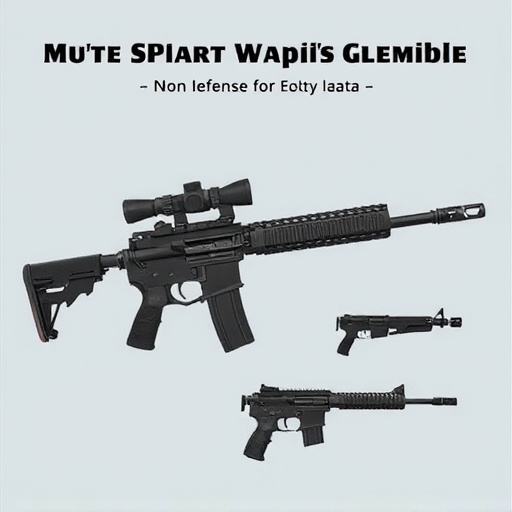Non-lethal home defense weapons, including pepper spray, stun guns, tasers, and noise devices, provide safe and effective personal protection without causing permanent harm. Popular for civilian use due to growing concerns about public safety and active shooter incidents, these tools disrupt assailants' senses and mobility through electric shocks, blinding effects, muscle disruption, or startling noises. Training requirements are minimal, making them appealing for homeowners seeking to deter intruders responsibly. Legal accessibility varies globally; proper training, understanding risks, and staying within local statutes ensure safe use.
Discover the world of non-lethal home defense weapons – a growing option for personal safety without ending lives. This comprehensive guide explores various types, from stun guns and pepper spray to noise devices and tactical flashlights. We delve into their benefits, including deterrence and reduced harm, while considering legal aspects and safety practices crucial for responsible ownership. Learn how these tools can empower individuals to protect themselves and their loved ones effectively.
Understanding Non-Lethal Weapons: A Comprehensive Overview
Non-lethal weapons, also known as less-lethal options or force-at-a-distance tools, are designed to incapacitate or control individuals without causing permanent physical harm or death. These innovative devices have gained significant traction in recent years, particularly within law enforcement agencies and home security circles, as a more responsible approach to self-defense and crowd control. The primary focus of non-lethal home defense weapons is to provide individuals with the means to protect themselves and their properties while minimizing the risk of severe injury or death.
This category of weaponry encompasses a wide range of tools, from pepper spray and stun guns to tasers and noise devices. Each option is engineered to disrupt an assailant’s senses, mobility, or both, allowing users to escape dangerous situations or temporarily subdue attackers until help arrives. With the rise of active shooter incidents and increasing concerns about public safety, non-lethal home defense weapons are becoming increasingly popular among civilians who seek effective yet safe methods for personal protection without resorting to lethal force.
Types of Non-Lethal Home Defense Weapons
Non-lethal home defense weapons offer a range of options for individuals seeking to protect their spaces without resorting to fatal force. These tools are designed to incapacitate or deter intruders, providing a safe and effective alternative for many homeowners. From stun guns and pepper spray to noise devices and Tasers, the market is diverse, catering to various needs and preferences. Stun guns, for instance, deliver a powerful electric shock, temporarily paralyzing an attacker, while pepper spray causes temporary blindness and severe irritation, allowing the user to escape or summon help.
Tasers, another popular choice, use electrical current to disrupt muscle control, rendering the target immobile. Noise devices, like personal alarms, can startle and disorient intruders, giving homeowners a crucial opportunity to get away. Each of these non-lethal weapons has its advantages, from ease of use to minimal training requirements, making them appealing options for those who prioritize safety without lethal consequences.
Benefits and Considerations for Their Use
Non-lethal home defense weapons offer a significant advantage in personal safety, providing an effective deterrent for potential intruders without causing permanent harm. These tools allow individuals to protect themselves and their loved ones, giving them time to escape or summon help. The use of non-lethal force can also reduce the likelihood of escalated violence, as it enables users to control and subdue attackers without taking their life. This is particularly relevant in domestic settings where lethal force may not be justified or desired.
When considering non-lethal home defense weapons, several factors come into play. Range and accuracy are critical; individuals must be able to deploy the weapon effectively from a safe distance. Durability and reliability are also essential, ensuring that the device functions correctly when needed most. Additionally, legal implications and local regulations should be thoroughly understood to avoid any potential consequences. Proper training and familiarity with the weapon are paramount to ensure its safe and responsible use.
Legal and Safety Aspects of Owning Non-Lethal Defensives
The legal landscape surrounding non-lethal home defense weapons varies significantly across jurisdictions, reflecting a delicate balance between personal safety and public order. Owning and carrying such devices is often subject to strict regulations, requiring individuals to be well-informed about their local laws. Some regions permit only specific types of non-lethal weapons, such as pepper spray or stun guns, while others may impose restrictions on the level of force that can be used for self-defense. It’s crucial for homeowners considering non-lethal home defense weapons to conduct thorough research and consult legal experts to ensure compliance with local statutes.
Safety is paramount when it comes to non-lethal defensive tools. Users must receive proper training and understand the potential risks and consequences associated with each weapon. Misuse or improper handling can lead to unintended injuries, especially in high-stress situations. Regular maintenance and care of these devices are essential to guarantee their reliability and effectiveness when needed. Additionally, fostering a culture of de-escalation and peaceful conflict resolution complements the responsible ownership of non-lethal home defense weapons, promoting safer communities overall.
